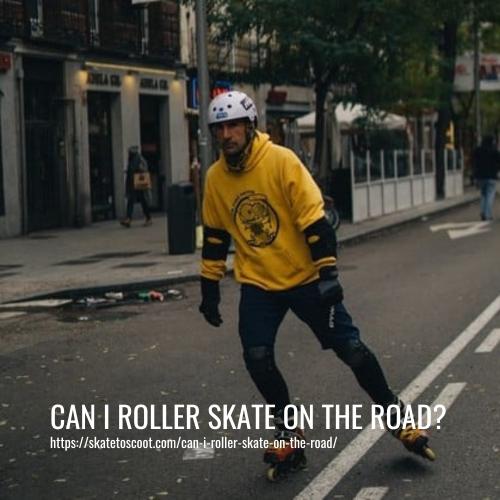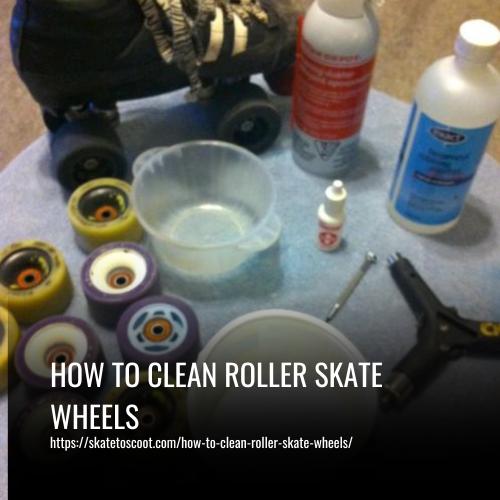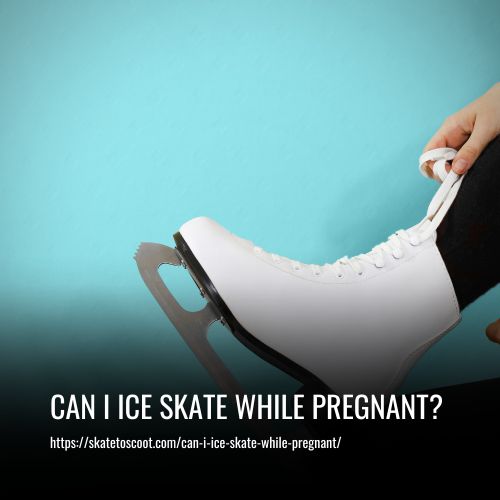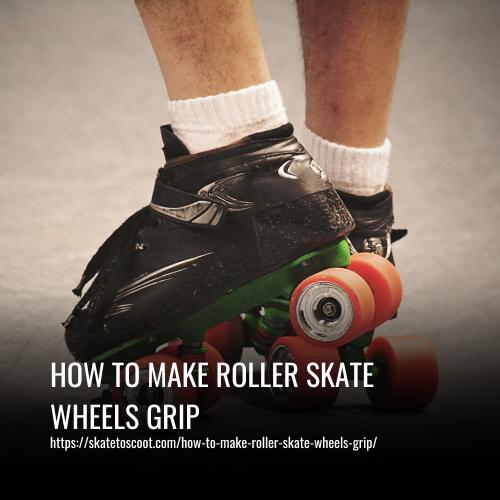As an Amazon Associate we earn from qualifying purchases.
Roller skating on the road can be dangerous and is generally not recommended. It is safer to skate in designated areas such as skate parks, roller rinks, or on sidewalks and bike paths. Skating on the road can put you at risk of accidents with vehicles and other hazards.

Are Roller Skates Made To Use On Roads
Are roller skates made to be used on roads? The short answer is: no. Roads typically have bumps and cracks, which can easily derail your balance as you skate, potentially leading to falls and other accidents. Additionally, there’s always a danger of traffic when it comes to roads. It’s important to note that some roads are smoother, with less traffic than others. But even those roads could still pose dangers, in the form of pebbles and rocks that could trip you up or cars that get too close for comfort.
The type of wheels on your skates does matter when it comes to how safe you’ll be if you decide to hit the road with them. Indoor wheels are harder and smoother than outdoor ones, meaning they’re better suited for an indoor surface. But even having outdoor wheels will only do so much to protect you in the face of all the uncontrollable elements of roller skating on a public roadway.
Is It Hard To Roller Skate On The Road
Roller skating on the road presents more difficulty than indoor skating, due to its unpredictable terrain. Uneven surfaces with potholes and cracks, as well as uphill and downhill slopes, are all hazards you have to keep in mind. You’ll also need to be aware of obstacles like cars, cyclists, and pedestrians which will make your journey even more difficult.
Perhaps the biggest concern for skaters on the roads is their safety. Due to the hard concrete surface, a fall can result in more serious injury than at an indoor skating rink.
In addition, there’s always a risk of falling into traffic and being hit by a vehicle. Worse still, when you do fall there’s nothing that you can grab onto (like a wall) that might break or slow your momentum.
What Roller Skates Are Best For Roads
When it comes to selecting roller skates for the roads, the wheels are the most important attribute to look for. Soft wheels and long stems for the toe stops will give you better acceleration and a smoother ride, while a boot with a heel can help shift your weight onto the ball of your foot for added agility.
For flat skates, you’ll get faster speed, more push when going forward, increased stability on ramps, better ankle support, and easier jumps. And if you tend to be prone to falling backward while skating, flat skates are better!
On the other hand, high heel skates keep your weight more toward the front and make it harder to fall backward – perfect for those starting in roller skating. Traditional skates are often seen as more stable than inline ones and provide a great option for downhill skating.
No matter what type of road skating you plan to do, determining what roller skates are best equipped to handle them is key to getting started safely!
How to Roller Skate on the Road
Skating on the roads is one of the most thrilling experiences. However, before engaging in such an activity, safety should always be a priority. In this article, we will provide some useful guidelines for how to roller skate on the road with maximum safety in mind. Now let’s get started!
1. Use the Right Side of the Road
When it comes to roller skating on the road, it’s important to use the right side of the road to reduce the risk of being hit by a car. In countries where people drive on the right side of the road, such as the US and the UK, you should only use the same side of the road as everyone else so that there is no confusion with other motorists. This means you should never skate in an opposing direction on a much-trafficked street or highway.
Remember to always keep your safety in mind when skating on any type of public roadway do your best to be aware of your surroundings and give drivers plenty of room throughout all turns.
2. Use Proper Skating Technique
If you want to skate safely, it’s important to know and use the right side of the road. By using the proper skating technique and staying on the right side of the road, you can be sure that you are distributing your weight evenly and keeping yourself more stable while cruising on your wheels. This is especially important if there are other skaters or vehicles around you.
In addition to knowing which side of the road to stay on, it’s also essential to learn how to stop properly when roller skating as this could save your life! Some easy-to-pull roller skating stopping techniques include; Toe Brake, Plow Stop, and T-Stop. Knowing these stops will increase your safety on the roads by ensuring that you know how to stop if needed.
3. Wear Protective Gear
Whenever you go roller skating—whether it’s on the road or in a skatepark—it is highly recommended that you always wear protective gear. This includes items like helmets, elbow pads, wrist guards, knee pads, and shin guards. Doing so guarantees your safety while letting you have a good time without worrying about getting seriously injured.
These pieces of protective gear work together to minimize the impact of any falls or collisions, helping to reduce the likelihood of serious injury while also making sure that even if you do experience an impact, its severity is significantly decreased. Protective gear is particularly important when running strangers on road skating as cars don’t stop for skaters.
All in all, wearing protective gear anytime you go roller skating is an absolute must for keeping skaters safe and sound!
4. Avoid Distractions like Unnecessary Music
Listening to music while roller skating is a great way to round out the experience, however, it’s important to be aware of the potential distractions it can cause. Headphones and earphones can easily distract you while skating, leading you to miss auditory cues of hazards around you. This could result in accidents if a car begins honking or somebody calls out for help – but you may not hear them because the volume of your headphones is too high.
For the sake of your safety, it’s best to avoid unnecessary distractions like music while skating on busy roads. Pay special attention to what’s around you and take full precautions with your actions. Don’t risk your life by carelessly putting yourself in hazardous situations; keep calm and skate safely!
5. Follow Traffic Rules
Following traffic rules is essential for staying safe on the roads. Whether you’re driving a car or traveling on foot, it’s important to follow the same set of regulations as cars on the road. This means stopping when the lights turn red and moving when they turn green, as well as always abiding by all road signs and other traffic rules that are set in place by your country’s transport authority.
By following these rules, we can ensure that everyone stays safe while traveling from one destination to another. Sticking to traffic laws not only prevents accidents but also contributes to smoother and faster transportation across the nation. So make sure that you obey all road regulations whenever you’re out and about!
6. Wear Bright colored Clothes
When you roller skates on the roads, you must be visible to other road users. The best way to make sure of this is by wearing bright-colored clothes such as green, red, orange, and yellow. These colors can help your visibility significantly and help in avoiding potential accidents.
Another option is wearing reflectors, which also serve the same purpose as bright colors by making you more noticeable on the road. So whatever you wear when you go out roller skating, just make sure it is either brightly colored or has a reflector!
7. Carry a Whistle
Carrying a whistle while roller skating is an important safety measure. It can quite literally be a lifesaving measure. That’s because it allows you to quickly and easily alert other road users like pedestrians, cyclists, and motorcyclists that you are nearby. This can help ensure that everyone stays safe and aware of what is going on around them.
Without a whistle, warning road users of your approach may be difficult or even impossible while roller skating at speed. It just makes sense to have one handy to make sure that you – and those around you – stay safe.
8. Control Your Speed
When it comes to roller skating, it is best to be safety conscious and consider the well-being of yourself and other people on the road. Although skating fast might be exciting, it should never be done unless it’s necessary.
And when you do want or need to skate at a faster pace, you must make sure that you have mastered the fundamental techniques needed for doing so safely. This includes being able to stop quickly in case of any unexpected circumstances that may arise while skating.
At times, making an instant stop isn’t even possible, leaving you vulnerable and exposed to potential injuries or accidents. The safest thing that one can do is to roller skate at a moderate speed instead. By following this approach, you can easily avoid any deadly mishaps while enjoying your ride.
9. Use Roller Skates in the Right Condition
When you go roller skating, it’s not just about what skates you wear – it’s also important to make sure they fit properly. Your skates should fit snugly around your feet without being too tight or too loose. Too tight roller skates can cause discomfort and pain in your feet and ankles, while skates that are too loose can lead to pronation and supination.
And if you’re looking to roller skate fast, wearing shoes that are the wrong size can even cause your feet to come out of your roller skates! That’s why it’s essential to use roller skates in the right condition. Make sure they fit properly and provide enough support for your feet when you skate – so you don’t experience any discomfort or lose control on the rink.
Can You Use Quad Roller Skates Outside
Are you interested in skating outdoors with a pair of Quad Roller Skates? Well, the answer is yes! As long as your skates have the right type of wheels on them, you can use quad roller skates outside.
Traditional quad skates look like boots or shoes and have two wheels on one side and two more on the other. They typically come with a stopper under your toes. However, these types of skates are usually designed for indoor skating instead of outdoor skating.
The good news is that if you prefer to go outdoors, all you need to do is switch out the indoor wheels for ones made for use outside. Once you’ve got those newfound wheels added onto your beloved skates, you’ll be ready to roll!
What Are The Laws And Rules Regarding Roller Skating Outside
When it comes to roller skating outside, you need to make sure that you know the laws and regulations for your area. While these can vary depending on where you live, more often than not the same rules apply as if you were riding a bicycle outdoors.
This means going in the same direction as traffic. To make sure that you’re following all the local laws properly, it is best to check with your local authorities first.
In most cases, roller skaters are required to stay on the sidewalk instead of rolling along the road itself. However, some places have set up designated “bicycle lanes” which also allow roller skaters to travel alongside regular cyclists on their path safely removed from traffic.
Regardless, it is important to check with the relevant authorities in your area before hitting those sidewalks and hitting speeds!
Things to Remember When Roller Skating on the Road
If you’re going to take a spin on your roller skates, it’s important to remember a few key things to stay safe.
First of all, never wear headphones. While they might be okay indoors, when you’re roller skating outdoors you need to hear what’s going on around you so that you can avoid any potential danger.
Secondly, always put safety first by wearing a helmet, elbow pads, and knee pads whenever skating. Don’t settle for anything less! Thirdly, don’t walk while wearing your skates – go too slow and the cracks on the ground could catch your wheels which could cause an accident! Plus it’s important to bend your knees while skating – this will make it easier to go over rocks and potholes without being dangerous or uncomfortable.
Finally, make sure you keep your body weight low. This will reduce the chances of falls and if an accident happens – it will be less painful because you’re at a lower angle!
Relax your arms, keep your chin up, and transfer your body weight left and right for smooth sailing on those wheels!
Do you have to wear a helmet on roller skates?
The short answer is, no – you are not legally required to wear a helmet when using roller skates. Of course, this doesn’t mean it is not a wise idea! Wearing a helmet can protect your head from any potential trauma in the case of an accident.
Other laws governing how you ride must still be abided by when roller skating though, such as staying on the left side of a shared path or footpath and giving pedestrians the right-of-way. You should also be aware that although drunk-driving rules do not apply to bicycles, they do to skateboarding and rollerblading, so if you’re intoxicated it’s best to stay off your skates.
Why You Should Avoid Roller Skating on the Road
Roller skating on the road is not always a good idea. Here are some reasons why it may not be wise to do so:
1. Busy Traffic
Roller skating on roads can be dangerous due to the amount of traffic present. Highways are the most hazardous in this regard, as they are often filled with cars and other vehicles traveling at high speeds. This makes it incredibly risky for any roller skater to attempt to weave in and out of the traffic without being experienced.
In addition, there is a huge risk of becoming involved in an accident if a roller skater is caught off guard by a car or truck speeding by. That is why it’s best to avoid busy roads and highways while attempting to roller skate on the road. Instead, stick to access roads within your neighborhood with minimal traffic.
2. Unfriendly Skating Surfaces
If you’re looking for a place to go roller skating, the road is not the best option. Roads can often be full of potholes, rocks, sand, and soil that can make roller skating hazardous and uncomfortable.
Not only can tripping and falling becomes a danger, but skating on such terrain can use up your energy quickly. Unfriendly surfaces like these also can wear out your roller skate wheels much faster than in normal conditions.
If you want a good roller skating experience, it’s always best to avoid the roads and stick to smooth surfaces free from hindrances like those mentioned above.
3. Bylaws Forbidding Roller Skating on the Road
When it comes to roller skating, cities, towns, and municipalities take safety seriously. That’s why many have created bylaws to control the activity of roller skating within their jurisdictions.
These bylaws are important to be aware of because breaking them can come with consequences such as a fine or even losing your roller skates! Typically, you’ll get a warning the first time you break the bylaw. However, repeated offenses may lead to fines or the loss of your skates.
So make sure that you’re familiar with your city or town’s roller skating laws before taking your skates out on the road- it’s worth it for your safety and wallet!
4. Roller Skates Wheels Quick Wear
Roller skating can quickly wear out your wheels, especially if you’re using the wrong kind of wheels for the surface you’re skating on. If you want to avoid replacing your wheels frequently, it’s important to ensure that you have the right kinds of wheels for whatever situation you’ll be rolling in.
Indoor wheels are soft and designed to handle smooth surfaces, while outdoor wheels should be sturdier to navigate asphalt, concrete, or any other rough terrain. When roller skating on the road, you must use outdoor-specific hard wheels as indoor ones might not hold up against wear and tear.
If a new set of roller skates isn’t in your budget right now, don’t worry! There are ways to make do and still get a safe and smoother ride. Buying an extra set of outdoor-ready hard wheels is perfect for when you want to skate outdoors—all you have to do is switch them out with softer ones once back inside!
Is Roller Skating A Form Of Transportation?
Roller skating is an activity that can be seen as both a sport and a leisure activity, but it is also being used as a form of transportation. Both in-line and street skaters use roller skates for this purpose, although in different ways.
In-line skaters fit special wheels and boots over their shoes and move side by side on any flat surface, such as specially designed tracks made of concrete or asphalt.
This terrain contains grooves to help with traction and can be found in parks, playgrounds, community centers, or shopping malls. Street skaters use traditional tennis ball wheels attached directly to their feet and travel in groups of 7 to 15 people who call out directions to each other as they go.
Given the growing popularity of roller skating as a form of transportation, it’s clear that it has become a viable option for getting around town. It’s not only convenient but also fun which makes it attractive to both experienced skaters and newbies too!
FAQs
Yes, it is possible to roller skate on the sidewalk if you take certain precautions. Skate at a low speed and pay attention to the surface of the sidewalks since some can be hazardous due to bumps and cracks that could cause you to trip or fall. Additionally, wear protective gear such as helmets and wrist guards when skating on the sidewalk so that you’re prepared in case of an accident.
It might also be worth looking into any local ordinances before you skate outside since some cities have laws against skating on streets or sidewalks. Overall, if done carefully, skating on the sidewalk can be a great way for you to get outside and enjoy a little exercise!
It’s important to use outdoor-specific hard wheels when roller skating on the road, as indoor wheels might not hold up against wear and tear. Buying an extra set of outdoor-ready hard wheels is a great way to ensure you have the right kind of wheels for your situation.
Yes, roller skating can be a safe form of transportation if done with caution. Make sure to wear protective gear such as helmets and wrist guards, and pay attention to the surface of the sidewalks since some can be hazardous due to bumps and cracks that could cause you to trip or fall. Additionally, it’s worth looking into any local ordinances before you skate outside since some cities have laws against skating on streets or sidewalks.
Yes, there are different types of wheels for roller skating depending on where you’ll be skating. Indoor wheels are soft and designed to handle smooth surfaces, while outdoor wheels should be sturdier to navigate asphalt, concrete, or any other rough
Conclusion:
Roller skating on the road can be a fun and relatively safe activity if proper safety precautions are taken. To avoid injuries or accidents, it is important to stay aware of your surroundings and abide by traffic laws. Wearing protective gear such as helmets and elbow pads, choosing quiet roads with minimal traffic, and finding a roller rink that offers classes can all help you enjoy this activity safely.
Amazon and the Amazon logo are trademarks of Amazon.com, Inc, or its affiliates.



